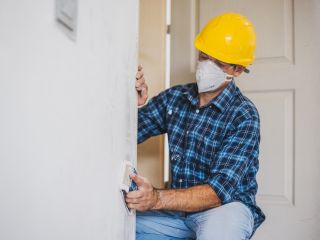
Sanding drywall can be a challenging and messy task, but it’s crucial for achieving a professional finish. With the right techniques and tools, you can transform your drywall installation into a smooth, flawless surface. Here are some key tips for sanding drywall effectively:
1. Tool Selection
The choice of tools can significantly impact the quality of your sanding job. Here’s a breakdown of popular sanding tools:
- Hand Sander: The most common tool, using precut sandpaper for a smoother finish. Opt for finer grit sandpaper for the best results. Drywall screens can help reduce dust collection but may affect finish quality.
- Pole Sander: Ideal for large areas and high walls. Use short sideways or long lengthwise strokes with the sander’s head slightly angled. Avoid perpendicular strokes to prevent surface damage.
- Rotary Sander: Available at most rental stores, this tool speeds up the process and effectively sands the surface while minimizing dust. However, it’s less effective in tight corners and intricate areas.
- Vacuum-Attached Sander: Attach a hand sander to a vacuum for efficient dust collection. Some pole sanders come with this feature for enhanced effectiveness.
2. Sanding the Corners
Rotary and pole sanders often struggle with corners and may cause damage. Use a sponge sander or folded drywall sandpaper to tackle these tight areas effectively.
3. Precise Techniques for Better Results
Ensure the mud is completely dry before sanding. Use light to moderate strokes with your sandpaper and keep the sander moving. Avoid sanding in a straight line to prevent depressions. For significant ridges or gouges, add another layer of joint compound instead of excessive sanding.
4. Checking the Sanded Area
After sanding, inspect joints, walls, and corners under different angles using a flashlight. This helps identify blemishes or imperfections. Minor issues can be fixed with a sponge sander, while deep gouges may require recoating with joint compound and additional sanding.
5. Dust Management
Effective dust management is crucial. Always use masks, eye protection, and dust-catching tools to keep the workspace clean and safe.
For expert drywall finishing that prepares your walls perfectly for primer and paint, consider professional services like Drywall Repair Castaic. They offer precise and effective solutions to ensure a flawless wall finish.
With these tips, you’ll achieve a smooth, professional finish for your drywall projects. Happy sanding!

